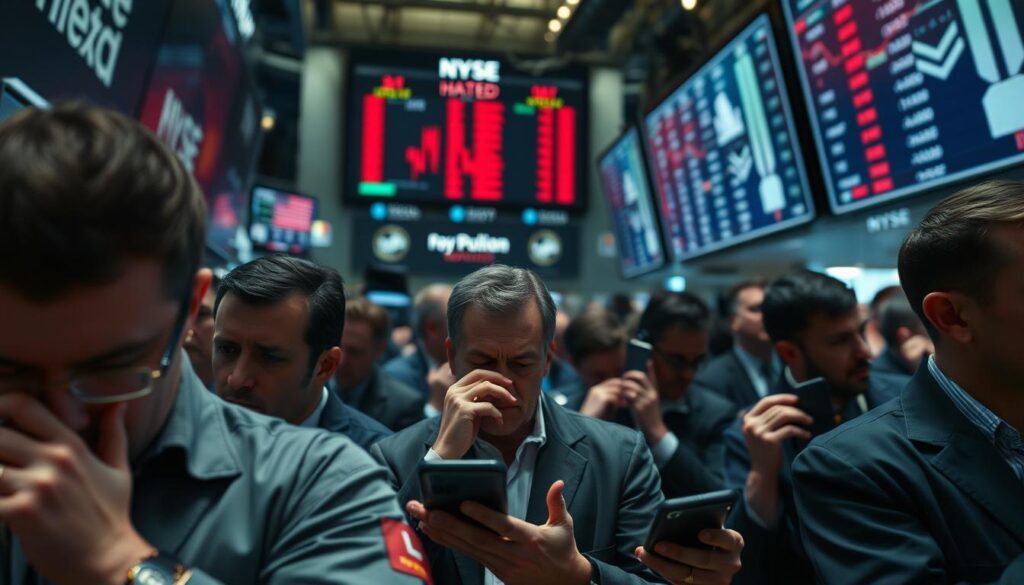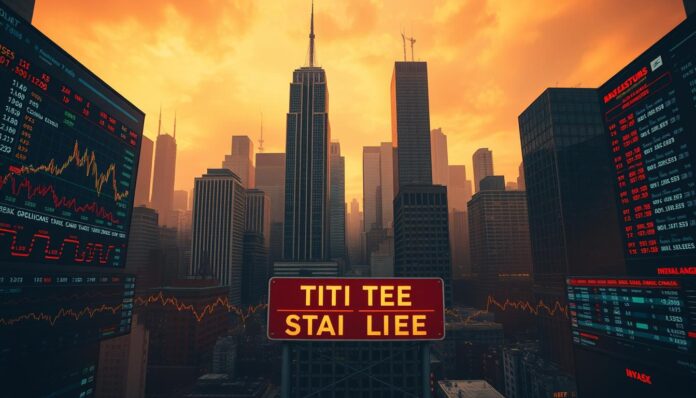Stock markets move fast, but sometimes trading stops suddenly. When exchanges halt a stock, it’s not random. Why Do Stocks Get Halted? Often, it’s to protect investors. Exchanges like the New York Stock Exchange or Nasdaq pause trading for reasons like sudden news, fraud concerns, or extreme price swings. What triggers a stock halt could be a company announcement, suspicious trading, or market chaos. These pauses give everyone time to process information and avoid panic. For investors, understanding halts means knowing when markets pause—and why it matters.
Key Takeaways
- Halts protect markets by stopping trades during critical events.
- Major news or trading irregularities often trigger halts.
- Regulators like the SEC enforce rules to ensure fair markets.
- Investors face uncertainty when trading suddenly stops.
- Learning about halts helps manage risks in real-time.
Understanding Stock Halts: An Overview
Stock halts pause trading to maintain market stability. Let’s break down the basics to answer questions like Why are stocks halted and uncover stock halts reasons.
Definition of a Stock Halt
A stock halt stops buying or selling shares temporarily. Exchanges like the NYSE or Nasdaq enforce halts to address irregular activity or urgent information. Unlike permanent suspensions, halts aim to protect investors during critical moments.
Types of Stock Halts
- Regulatory Halts: Issued by regulators like the SEC to address fraud or misinformation.
- Circuit Breakers: Automatic pauses during extreme price swings. Investors tracking penny stocks often face these due to high volatility.
- News-Driven Halts: Announcements like earnings reports or mergers may trigger pauses for fairness.
Duration of Halts
Halts vary widely:
- Minutes: Short pauses for market冷静 periods during sudden price drops.
- Hours: Common for urgent corporate news releases.
- Days or longer: Investigations into insider trading or financial fraud can extend halts indefinitely.
Understanding these basics helps investors anticipate disruptions and adapt strategies. Stay tuned for deeper dives into reasons behind halts in the next section.
Reasons for a Stock Halt
Stock halts aren’t random. They occur for specific reasons for trading halts, each tied to market stability or transparency. Let’s break down the main triggers investors should know.
Significant News Announcements
When a company shares major updates—like Tesla’s battery breakthrough or Pfizer’s vaccine trials—exchanges may pause trading. This gives investors time to digest the news. For example, in 2023, AMD halted trading after announcing a chip partnership, preventing rushed reactions.
- Earnings reports that beat or miss expectations
- Mergers & acquisitions (e.g., Disney’s Fox acquisition)
- Legal issues like SEC investigations
Market Volatility and Unusual Activity
Rapid price swings can trigger automatic halts. In 2020, GameStop’s stock skyrocketed due to Reddit-driven buying, leading exchanges to pause trading. These trading halt causes aim to curb panic selling or speculative bubbles.
- Circuit breakers kick in during extreme price drops
- Unusual trading volume spikes
- Manipulation suspicions (e.g., Robinhood restrictions in 2021)
Corporate Actions and Events
Companies often halt trading for structural changes. When Apple split its stock in 2020, a brief halt allowed systems to adjust. Similarly, bankruptcy filings or executive changes can freeze trading until details are clear.
These pauses ensure fair access to information. While halts disrupt short-term strategies, they protect long-term market fairness.
The Role of the SEC in Stock Halts
When stock market suspension occurs, the Securities and Exchange Commission (SEC) plays a critical role in ensuring fair practices. This federal agency enforces rules that protect investors and maintain market stability. Their actions often clarify Why Do Stocks Get Halted, especially in high-stakes scenarios.
Overview of SEC Regulations
Key rules like Rule 12k-1 empower the SEC to pause trading when fraud or misinformation risks harm investors. These regulations aim to prevent panic and ensure transparency. For instance, halts may follow corporate misconduct or unverified rumors.
SEC’s Authority and Guidelines
The SEC can intervene directly or require exchanges to act. Below compares their roles:
| Factor | SEC Actions | Exchange Actions |
|---|---|---|
| Authority Source | SEC Regulations | Exchange Rules |
| Common Triggers | Legal Investigations, Compliance Issues | Price Swings, News Gaps |
Impact of SEC Actions on Trading
SEC-ordered halts often signal deeper issues. Investors may see prolonged pauses during probes into fraud or accounting errors. For example, a halt might follow allegations of financial misreporting, as seen in cases like Enron or Valeant. Such actions remind traders that Why Do Stocks Get Halted isn’t just about volatility—it can mean legal trouble.
These measures balance market fairness with liquidity needs. While halts can unsettle portfolios, they protect against crises by halting panic-driven decisions.
How Stock Halts Affect Investors
Stock trading pauses create unexpected challenges for investors. When stocks halt suddenly, the uncertainty can spark strong emotions. Understanding these effects helps navigate the situation better.

Emotional Impact on Investors
Market halts disrupt normal trading rhythms, often causing stress. Common reactions include:
- Anxiety: Not knowing when trading resumes fuels doubt.
- Panic: Fear of missing out or losing gains escalates.
- Frustration: Limited control over portfolios can feel overwhelming.
Strategic Considerations During Halts
Why are stocks halted? While emotions run high, halts also offer opportunities. Use this time to:
- Reassess your position: Review original reasons for investing.
- Research updates: Check news or SEC filings for halt causes.
- Plan next steps: Draft a strategy before trading resumes.
| Emotion | Action Step |
|---|---|
| Anxiety | Review investment goals |
| Panic | Verify official announcements |
| Frustration | Outline post-halt moves |
Halts may feel inconvenient, but they force冷静反思. Stay informed and avoid impulsive decisions. This pause can turn uncertainty into a chance to make wiser choices.
Trading Halts vs. Trading Pauses
Stock trading pauses and full halts are both market tools, but their purposes and impacts differ. Understanding these differences helps investors act wisely during market disruptions.
Key Differences
Let’s break down the core contrasts:
- Triggers: What triggers a stock halt often includes corporate news, fraud investigations, or SEC action. Pauses usually start automatically when prices swing too sharply.
- Duration: Halts may last hours or days. Pauses are short—often 5 to 15 minutes—to reset market stability.
- Approval: Halts require official approval from exchanges or regulators. Pauses activate via preset circuit breaker rules.
Implications for Investors
Reacting correctly matters:
“Pauses are market冷静 periods—don’t panic. Halts signal deeper issues needing attention.” — Market Analyst, NASDAQ
During pauses, use the break to reassess positions. Halts demand closer scrutiny of company news. Both aim to prevent chaos, but their signals differ:
- Pauses: Focus on volatility, not company-specific problems.
- Halts: Often indicate urgent corporate or regulatory developments.
Stay informed by tracking triggers like circuit breaker thresholds or SEC announcements. Knowing the difference keeps strategies aligned with market realities.
Market Reactions to Stock Halts
When trading resumes after a halt, markets often react with heightened volatility. Investors must understand how price swings and sentiment shifts shape post-halt dynamics. Let’s explore how these reactions unfold in real-world scenarios.
Price Fluctuations Post-Halt
Prices can swing dramatically once a stock resumes trading. Here’s how different trading halt causes influence outcomes:
| Scenario | Typical Price Movement |
|---|---|
| Positive news (e.g., merger announcements) | Rapid upward spikes |
| Negative news (e.g., financial scandals) | Sharp declines |
| Neutral/mixed info | Wild swings until clarity emerges |
Low liquidity during reopenings often amplifies these gaps. Retail traders may rush in, while institutions wait for data digestion.
Investor Sentiment and Reactions
- Retail investors often panic-sell or buy impulsively, driven by social media buzz.
- Institutional traders analyze stock halts reasons before acting, prioritizing fundamentals over emotion.
“Post-halt volatility reflects uncertainty until the market recalibrates,” noted the SEC’s 2023 market behavior report.
Emotions like fear or greed dominate early trading, but rational analysis usually follows. Patience helps investors avoid impulsive mistakes.
The Process of Lifting a Stock Halt
When a stock market suspension ends, orderly resumption is key. Here’s how the process unfolds:
Communication from Exchanges
- Exchanges like NASDAQ and NYSE send alerts via email, social media, and their platforms.
- Investors receive updates on timing and rules for trading restarts.
- Public announcements clarify why the halt occurred and if risks remain.
Trading Resumption Protocols
Resumption often starts with a pre-opening auction to set a fair price. Exchanges use these steps:
- Automated systems match buy/sell orders to stabilize pricing.
- Traders receive real-time data to avoid abrupt swings.
- Monitoring continues post-resumption to prevent volatility.
“Transparency during resumption protects investors and market integrity.” — NYSE Trading Guidelines
Investors should review updates before trading resumes. Follow official channels like SEC filings or exchange websites to stay informed. While halts disrupt short-term plans, protocols aim to balance fairness and safety.
Case Studies: Notable Stock Halts
Stock market suspension and reasons for trading halts aren’t just theoretical—they shape real markets. Let’s explore two historic cases to see how these mechanisms work in action.

Example 1: The 2010 Flash Crash
In May 2010, the Dow Jones plummeted nearly 1,000 points in minutes during the Flash Crash. Automated trading errors triggered a sudden sell-off. Exchanges halted trading to stabilize markets. This event highlighted how reasons for trading halts can include technical glitches and systemic risks. Post-halt, regulators introduced circuit breakers to prevent future chaos.
Example 2: Enron’s Fraud Unraveling
When Enron’s accounting fraud became public in 2001, its stock crashed. Trading was paused to allow time for investigations. This case shows how stock market suspension protects investors during corporate scandals. The halt gave transparency as the SEC stepped in, exposing how misconduct disrupts markets.
Lessons Learned
These cases teach us:
- Halts protect markets from panic and misinformation
- Regulators use suspensions to enforce accountability
- Investors must monitor halts as signals for deeper issues
| Case | Trigger | Outcome |
|---|---|---|
| 2010 Flash Crash | Automated trading failures | New circuit breakers implemented |
| Enron Scandal | Financial fraud revelations | SEC investigations and legal reforms |
These stories remind us: halts aren’t just pauses—they’re tools to restore trust and stability in turbulent times.
How to Stay Informed About Stock Halts
Staying updated on what triggers a stock halt or why are stocks halted requires the right tools and knowledge. Here’s how to track halts and decode official updates:
Resources for Real-Time Updates
Use these platforms to monitor halts instantly:
- Bloomberg Terminal: Real-time alerts for listed halts and reasons.
- FINRA Market Volatility Site: Tracks unusual trading activity and halt notifications.
- SEC Filings Database: Search official halt announcements by ticker or date.
Understanding Press Releases
Exchange notices often use coded language. Here’s how to read between the lines:
| Term | Meaning |
|---|---|
| “Material News Pending” | Company has undisclosed major news (e.g., earnings leaks) |
| “Order Imbalance” | Buying/selling pressure causing price instability |
| “Regulatory Action” | SEC or exchange investigation underway |
Always cross-reference halt reasons with the why are stocks halted explanations from the issuer’s official statements. Follow Twitter handles like @NYSE or @NASDAQ for urgent alerts. Never rely solely on social media rumors—verify through official channels.
Preparing for Potential Halts as an Investor
Stock trading pauses are unpredictable, but proactive steps can reduce their impact on your portfolio. Here’s how to prepare for trading halt causes and stay in control.
Risk Management Strategies
Effective risk management starts with limiting exposure to volatile stocks. Consider these steps:
- Position sizing: Allocate smaller portions of capital to high-risk assets prone to halts.
- Stop-loss orders: Automate exits to avoid extended losses during unexpected trading halt causes.
- Contingency cash reserves: Keep 5-10% of portfolios in liquid assets for sudden market shifts.
Diversification and Portfolio Management
A well-diversified portfolio minimizes reliance on any single stock. Aim for:
| Asset Class | Target Allocation | Rationale |
|---|---|---|
| Large-Cap Stocks | 40% | Stability during market turbulence. |
| Bonds | 30% | Low-risk balance to offset volatility. |
| International Stocks | 20% | Reduces reliance on U.S. market-specific stock trading pauses. |
| REITs/Crypto | 10% | Alternative assets for diversification. |
Review allocations quarterly to ensure alignment with goals. Avoid overconcentrating in sectors historically prone to halts, like biotech or penny stocks. For deeper guidance on managing stress during disruptions, explore emotional resilience strategies.
Future of Stock Halts in Digital Trading
As markets grow more digital, stock halts reasons and reasons for trading halts face new challenges. Technology is reshaping how exchanges manage disruptions, from high-speed trading to blockchain-based systems.
Impact of Technology on Halts
- Algorithmic trading can trigger sudden price swings, forcing exchanges to adapt halt triggers.
- Decentralized finance platforms may test traditional halt frameworks, creating gaps in oversight.
- AI monitoring tools now flag irregular activity faster, reducing manual intervention.
Predictions for Market Evolution
Experts foresee:
| Current Practice | Future Trend |
|---|---|
| Blanket halts for volatility | Targeted halts for specific stocks |
| Manual oversight | Automated systems using real-time data |
| Nation-specific rules | Global standards for cross-border trades |
“Cryptocurrency market crashes show how decentralized systems need new halt mechanisms. Traditional markets must learn from these events,” says market analyst Sarah Lin, citing 2023 crypto volatility studies.
New tools like micro-halts and blockchain audits could address reasons for trading halts caused by misinformation or cyberattacks. Investors might see more dynamic halt rules tied to AI-predicted risks. Regulators may collaborate internationally to handle global market shocks, blending old and new halt strategies.
Conclusion: The Importance of Understanding Stock Halts
Stock halts occur for clear reasons—from sudden news to regulatory checks—so knowing why stocks get halted matters. By grasping these triggers, investors avoid panic when trading pauses hit. The SEC’s oversight ensures fairness, even during disruptions like those seen in past market events. Stock trading pauses aren’t just technical stops; they’re safeguards against chaos.
Armed with this knowledge, you’re better equipped to react calmly. Whether facing a halt due to fraud investigations or market swings, understanding the “why” behind halts lets you pivot strategies. Technology’s role in real-time updates, as discussed earlier, helps stay ahead. These moments aren’t just obstacles—they’re chances to reassess and adapt.
Remember, halts protect investors from misinformation and wild swings. When trading resumes, you’ll be ready with informed decisions. Keep learning through SEC resources and market alerts. With this guide, you’ve taken a key step toward mastering how to navigate these pauses confidently. Your next move? Stay informed and stay proactive.

